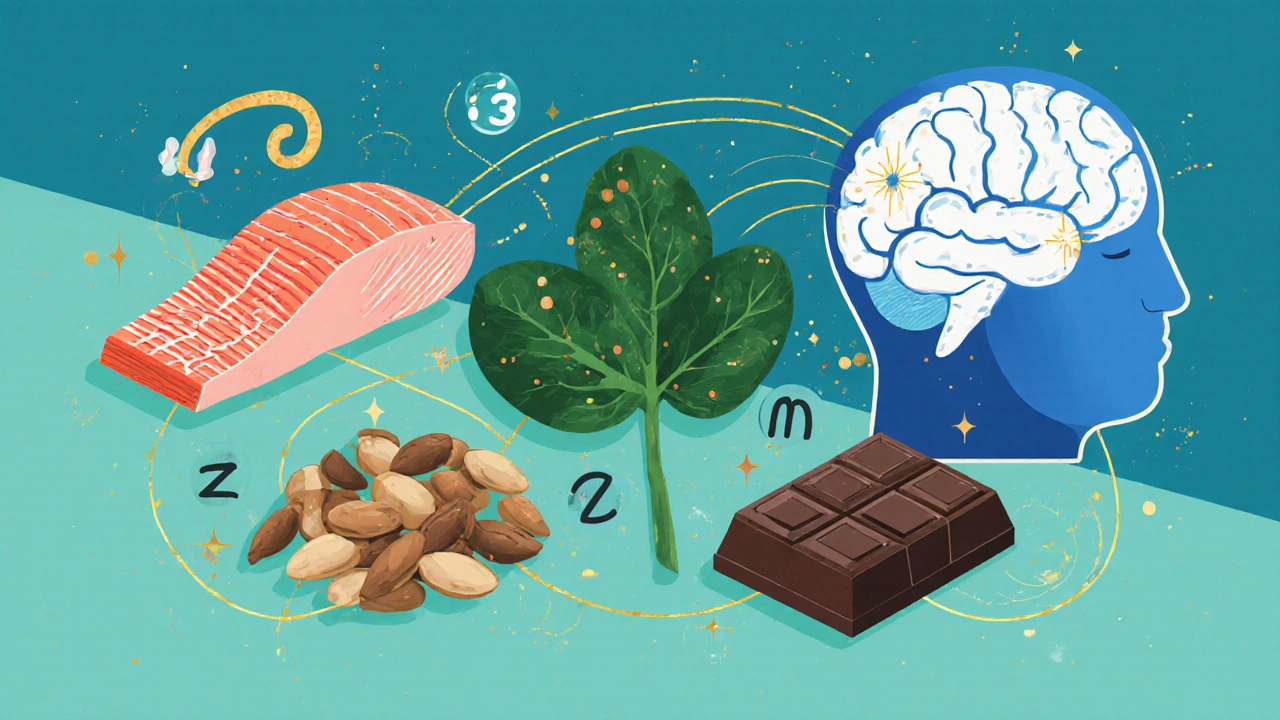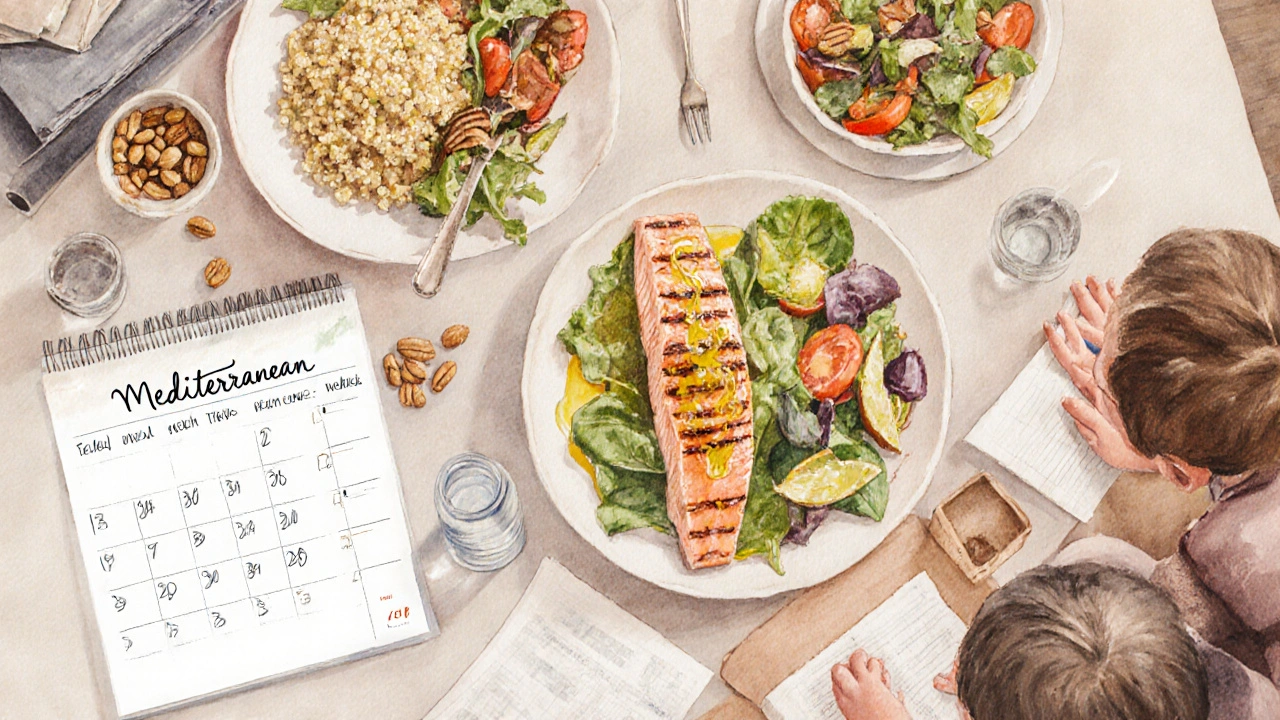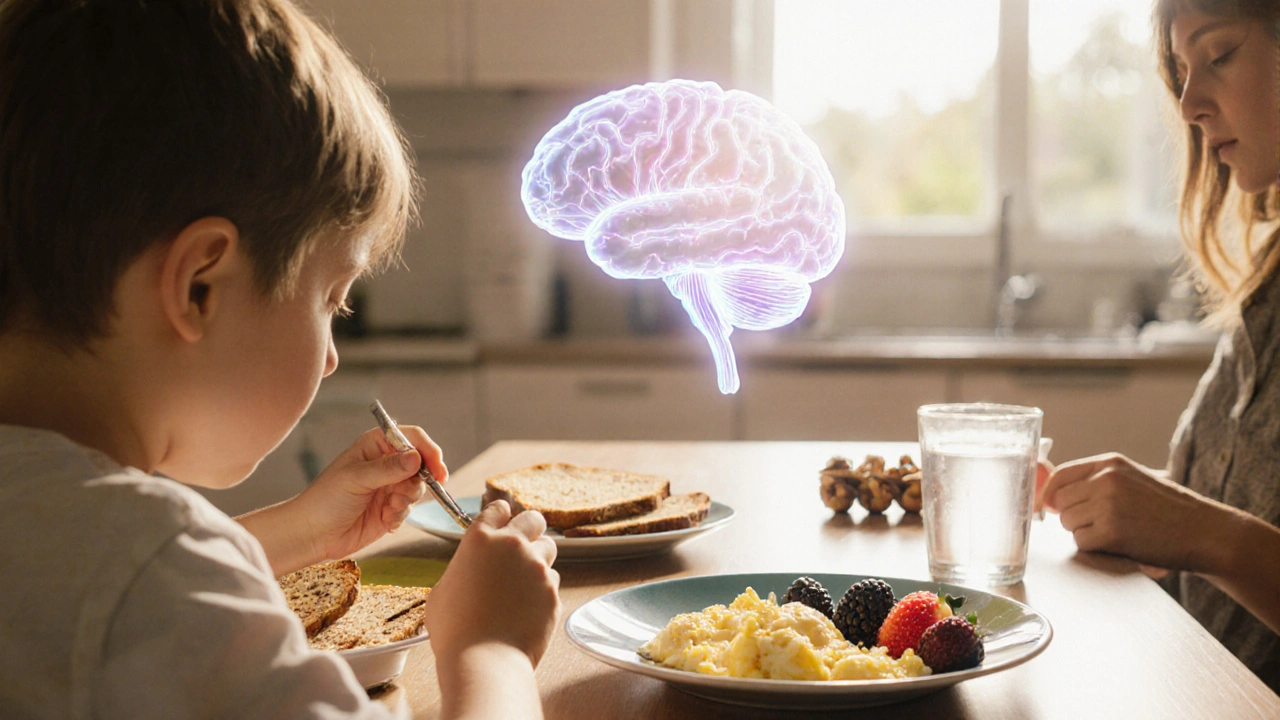ADHD Diet Impact Calculator
Adjust the sliders above and click "Calculate Symptom Impact" to see how your diet might affect ADHD symptoms.
When it comes to managing ADHD, a neurodevelopmental condition marked by inattention, hyperactivity, and impulsivity, diet can play a surprisingly big role. Parents, teachers, and adults with ADHD often wonder whether tweaking meals can calm the brain enough to see real improvement.
Key Takeaways
- Specific nutrients - especially omega‑3s, iron, zinc, and magnesium - have the strongest research backing for symptom reduction.
- High‑sugar foods, artificial colorings, and excessive caffeine can worsen hyperactivity and focus issues.
- Mediterranean‑style and DASH eating patterns consistently show modest but meaningful benefits.
- A structured meal schedule keeps blood‑sugar stable, which helps sustain attention.
- Track foods for a few weeks; look for patterns before making big changes.
Why Nutrition Matters for ADHD
The brain relies on a steady supply of fuel to keep neurotransmitters - the chemicals that transmit signals - balanced. When blood‑sugar spikes and crashes, the brain’s ability to regulate dopamine and norepinephrine (key players in attention) gets disrupted. Likewise, the gut microbiome produces short‑chain fatty acids that influence mood and cognition. In short, what you eat can either support or sabotage the neural pathways that underlie ADHD.
Core Nutrients With Evidence
Research over the past decade zeroes in on four nutrients that appear repeatedly in successful studies.
- Omega‑3 fatty acids are essential fats found in fish oil, algae, and some nuts that help build neuronal membranes and modulate inflammation. A 2023 meta‑analysis of 12 randomized trials reported an average 8‑point drop on the ADHD Rating Scale for children taking 1,000mg EPA+DHA daily.
- Iron is crucial for dopamine synthesis. Low ferritin levels are linked to poorer attention; supplementing 15mg elemental iron for 12weeks improved score consistency in 60% of participants with documented deficiency.
- Zinc supports neurotransmitter modulation and synaptic plasticity. Studies show that 30mg zinc per day can reduce hyperactivity ratings by up to 12% when baseline levels are low.
- Magnesium helps regulate NMDA receptors and smooth muscle tone, which can calm restlessness. A 2022 trial found that 250mg magnesium glycinate improved sleep latency and daytime focus in adolescents.

Foods and Substances to Limit
Not all foods are created equal. Certain items have been shown to aggravate ADHD symptoms.
- Sugar causes rapid glucose spikes followed by crashes, which can mimic inattention and impulsivity. Limiting sugary drinks to less than one per week is a practical starting point.
- Artificial food colorings (especially Red 40, Yellow 5, and Yellow 6) have been linked to heightened hyperactivity in several double‑blind studies. Opt for natural fruit pigments when possible.
- Caffeine can improve short‑term alertness for some, but excessive intake (over 200mg per day) may worsen anxiety and disrupt sleep, indirectly hurting attention.
- Highly processed carbohydrates (white bread, chips, pastries) lack fiber, leading to unstable blood‑sugar curves.
Eating Patterns That Support Focus
Rather than isolated nutrients, whole‑diet approaches provide a balanced nutrient matrix.
| Diet | Core Focus | Evidence Strength | Key Foods |
|---|---|---|---|
| Mediterranean diet | High omega‑3s, fiber, polyphenols | Strong - multiple RCTs show 5‑10% symptom reduction | Fatty fish, olive oil, nuts, leafy greens, whole grains |
| DASH diet | Low sodium, high potassium, magnesium | Moderate - observational studies link lower hyperactivity | Low‑fat dairy, lean poultry, fruits, vegetables, legumes |
| Elimination diet | Identify and remove trigger foods (e.g., colorings, gluten) | Variable - works for ~30% of children with clear sensitivities | Simple whole foods; re‑introduce one at a time to test |
Pick the pattern that fits your family’s cooking style and budget. The Mediterranean approach is often the easiest to sustain because it doesn’t require strict eliminations, just a shift toward whole, minimally processed foods.
Building an ADHD‑Friendly Meal Plan
- Start with a protein source at every meal. Eggs, beans, Greek yogurt, or lean meat keep amino acids available for dopamine production.
- Add colorful vegetables. The pigments often contain phytonutrients that support brain health.
- Include a healthy fat. A tablespoon of flaxseed oil, a handful of walnuts, or a serving of salmon supplies omega‑3s.
- Choose complex carbs. Quinoa, sweet potatoes, or whole‑grain bread provide slow‑release glucose.
- Schedule consistent snack times. A mid‑morning snack of apple slices with almond butter prevents blood‑sugar dips.
- Hydrate. Dehydration can mimic concentration lapses; aim for 6-8 cups of water daily.
- Track. Use a simple journal or app to note meals, mood, and focus levels for 2-3 weeks. Look for patterns - perhaps a reduction in symptoms after adding fish twice a week.

Common Pitfalls and How to Avoid Them
Even with a solid plan, families hit snags.
- “All‑or‑nothing” mindset. Skipping a single meal won’t ruin progress; focus on overall trends.
- Relying on supplements alone. Whole foods deliver synergistic nutrients that isolated pills can’t replicate.
- Ignoring food intolerances. If a child reacts to dairy, the elimination diet can pinpoint the culprit.
- Inconsistent timing. Irregular breakfast habits often lead to morning “brain fog.” Set a routine even on weekends.
Frequently Asked Questions
Can diet replace medication for ADHD?
Nutrition alone rarely eliminates the need for medication, but it can lower the required dose or improve residual symptoms. Most clinicians recommend combining evidence‑based diet changes with prescribed treatment when needed.
How long does it take to see results after changing diet?
Most studies report noticeable improvement after 4-8 weeks of consistent eating patterns. Individual response varies, so patience and tracking are key.
Are there any foods that can actually worsen ADHD?
Yes. High‑sugar snacks, processed meats, artificial colorings, and excessive caffeine are the most commonly cited aggravators. Reducing these can lead to clearer behavior.
Do omega‑3 supplements work for adults with ADHD?
Adults also benefit. A 2021 double‑blind trial showed that 1,000mg EPA+DHA daily improved self‑reported attention scores by 7% over six months.
Is a gluten‑free diet necessary for ADHD?
Only if there’s a diagnosed gluten sensitivity or celiac disease. For most people, eliminating gluten without a medical reason offers no extra benefit and may reduce fiber intake.
Next Steps & Troubleshooting
If you’ve tried the guidelines above and symptoms remain unchanged, consider these actions:
- Schedule a blood test to check ferritin, zinc, and magnesium levels.
- Consult a registered dietitian who specializes in neurodevelopmental disorders.
- Review current medication dosage with your prescriber; sometimes diet changes allow for a lower dose.
- Explore behavioral therapies (CBT, parent training) that complement nutritional work.
Remember, diet isn’t a magic bullet, but it’s a powerful lever you can control. By feeding the brain the right fuel, you set the stage for better focus, steadier moods, and a calmer daily routine.


Lorena Garcia
October 8, 2025 AT 22:00Honestly, the part about scheduling consistent snack times really hits home; it’s the kind of simple tip that actually sticks in a hectic household. Plus, seeing the bullet list of core nutrients makes it easier to explain to kids why fish is worth the smell.
Dietra Jones
October 8, 2025 AT 22:08i think this guide is great but i gotta say the grammer could use a lil work lol the info is solid and i love the simple table but sometimes the phrasing feels off like “recieve” instead of “receive”. just a heads up for future updates.
Victoria Guldenstern
October 9, 2025 AT 00:46It is remarkable that we still need a twenty‑page article to remind us that sugar can make a child jittery as a hummingbird. The evidence for omega‑3s is now as old as the hills yet we treat it like a new fad. Whole‑food diets are praised like they are a miracle cure for every modern ill. The Mediterranean plan is described as the holy grail of ADHD nutrition. One can argue that the emphasis on iron is simply because iron deficiency is common in the general population. The recommendations for magnesium sound like a whispered secret from a wellness guru. The article lists a handful of foods and calls them “brain‑boosting” as if a single walnut could rewire dopamine pathways. Casual readers might think that eliminating colorings will instantly silence a child’s hyperactivity. In reality the effect size is modest and often lost in the noise of daily life. The tone of the piece tries to be encouraging yet it slips into pseudo‑science at times. The inclusion of a calculator widget is a nice touch but also a reminder that we love quantifying everything. Still the advice to hydrate is sensible and rarely contested. The “structured meal schedule” suggestion is practical but not revolutionary. Many parents will already have set breakfast routines, so the tip feels redundant. Overall the guide manages to be both thorough and a bit over‑ambitious in its claims. Readers should take the information with a grain of salt and a spoonful of common sense.
Sharon Cohen
October 9, 2025 AT 00:55While most of the points are valid, I can’t help noticing that the guide glosses over the fact that supplements aren’t a cure-all and can even cause side effects if taken without medical supervision.
Nathan Hamer
October 9, 2025 AT 01:03Wow!!! This guide is a treasure trove!!! 🎉 The way it breaks down each nutrient is so helpful, and the practical meal‑plan steps give real hope!!! I love that it acknowledges that diet isn’t a magic bullet, yet still encourages us to try!!! Keep the science coming, and maybe sprinkle in a few more real‑world recipes!!! 😊
Tom Smith
October 9, 2025 AT 03:33The article does a solid job of summarizing current research, though the occasional overstatement about “miracle cures” could be toned down-after all, nutrition complements, not replaces, standard ADHD treatment.
Darla Sudheer
October 9, 2025 AT 03:41nice summary and the table is clear i appreciate the straightforward layout
Elizabeth González
October 9, 2025 AT 03:50The inclusion of both Mediterranean and DASH patterns provides a balanced perspective, and the recommendation to track meals aligns with evidence‑based practice. It is commendable that the guide avoids sensationalism while offering actionable steps.
chioma uche
October 9, 2025 AT 06:20Enough of these foreign diet trends! Our own traditional foods have kept generations sharp; we don’t need imported super‑foods to fix ADHD.
Satyabhan Singh
October 9, 2025 AT 06:28While respecting indigenous dietary practices, it is important to acknowledge that scientific studies across diverse populations have demonstrated the benefits of omega‑3 fatty acids and micronutrients, irrespective of cultural origin.
Keith Laser
October 9, 2025 AT 09:06Sure, the guide is thorough, but let’s be real-most families won’t follow a strict plan after a week, so the real impact might be minimal.
Winnie Chan
October 9, 2025 AT 09:15That’s a fair point, but even small tweaks can add up over time.